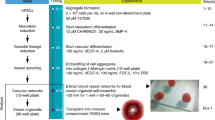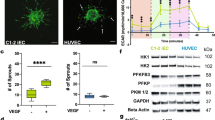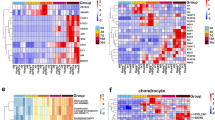Abstract
Mesenchymal stem cells can give rise to several cell types, but varying results depending on isolation methods and tissue source have led to controversies about their usefulness in clinical medicine. Here we show that vascular endothelial cells can transform into multipotent stem-like cells by an activin-like kinase-2 (ALK2) receptor–dependent mechanism. In lesions from individuals with fibrodysplasia ossificans progressiva (FOP), a disease in which heterotopic ossification occurs as a result of activating ALK2 mutations, or from transgenic mice expressing constitutively active ALK2, chondrocytes and osteoblasts expressed endothelial markers. Lineage tracing of heterotopic ossification in mice using a Tie2-Cre construct also suggested an endothelial origin of these cell types. Expression of constitutively active ALK2 in endothelial cells caused endothelial-to-mesenchymal transition and acquisition of a stem cell–like phenotype. Similar results were obtained by treatment of untransfected endothelial cells with the ligands transforming growth factor-β2 (TGF-β2) or bone morphogenetic protein-4 (BMP4) in an ALK2-dependent manner. These stem-like cells could be triggered to differentiate into osteoblasts, chondrocytes or adipocytes. We suggest that conversion of endothelial cells to stem-like cells may provide a new approach to tissue engineering.
This is a preview of subscription content, access via your institution
Access options
Subscribe to this journal
Receive 12 print issues and online access
$209.00 per year
only $17.42 per issue
Buy this article
- Purchase on Springer Link
- Instant access to full article PDF
Prices may be subject to local taxes which are calculated during checkout






Similar content being viewed by others
Change history
07 April 2011
In the version of this article initially published, the flow cytometry plot in Figure 4b corresponding to the condition HCMEC and TGF-β2 was incorrect. This plot has been replaced with the correct one in the HTML and PDF versions of the article.
References
Potenta, S., Zeisberg, E. & Kalluri, R. The role of endothelial-to-mesenchymal transition in cancer progression. Br. J. Cancer 99, 1375–1379 (2008).
Akhurst, R.J. & Derynck, R. TGF-β signaling in cancer—a double-edged sword. Trends Cell Biol. 11, S44–S51 (2001).
Thiery, J.P. Epithelial-mesenchymal transitions in tumor progression. Nat. Rev. Cancer 2, 442–454 (2002).
Thiery, J.P. Epithelial-mesenchymal transitions in development and pathologies. Curr. Opin. Cell Biol. 15, 740–746 (2003).
Hay, E.D. The mesenchymal cell, its role in the embryo, and the remarkable signaling mechanisms that create it. Dev. Dyn. 233, 706–720 (2005).
Boyer, A.S. et al. TGFβ2 and TGFβ3 have separate and sequential activities during epithelial-mesenchymal cell transformation in the embryonic heart. Dev. Biol. 208, 530–545 (1999).
Lai, Y.T. et al. Activin receptor-like kinase 2 can mediate atrioventricular cushion transformation. Dev. Biol. 222, 1–11 (2000).
Camenisch, T.D. et al. Temporal and distinct TGFβ ligand requirements during mouse and avian endocardial cushion morphogenesis. Dev. Biol. 248, 170–181 (2002).
Wang, J. et al. Atrioventricular cushion transformation is mediated by ALK2 in the developing mouse heart. Dev. Biol. 286, 299–310 (2005).
Okagawa, H., Markwald, Y. & Sugi, Y. Functional BMP receptor in endocardial cells is required in atrioventricular cushion mesenchymal cell formation in the chick. Dev. Biol. 306, 179–192 (2007).
Azhar, M. et al. Ligand-specific function of transforming growth factor β in epithelial-mesenchymal transition in heart development. Dev. Dyn. 238, 431–442 (2009).
Zeisberg, E.M., Potenta, S., Xie, L., Zeisberg, M. & Kalluri, R. Discovery of endothelial to mesenchymal transition as a source for carcinoma-associated fibroblasts. Cancer Res. 67, 10123–10128 (2007).
Zeisberg, E.M. et al. Endothelial-to-mesenchymal transition contributes to cardiac fibrosis. Nat. Med. 13, 952–961 (2007).
Zeisberg, E.M., Potenta, S.E., Sugimoto, H., Zeisberg, M. & Kalluri, R. Fibroblasts in kidney fibrosis emerge via endothelial-to-mesenchymal transition. J. Am. Soc. Nephrol. 19, 2282–2287 (2008).
Kizu, A., Medici, D. & Kalluri, R. Endothelial-mesenchymal transition as a novel mechanism for generating myofibroblasts during diabetic nephropathy. Am. J. Pathol. 175, 1371–1373 (2009).
Li, J., Qu, X. & Bertram, J.F. Endothelial-myofibroblast transition contributes to the early development of diabetic renal interstitial fibrosis in streptozotocin-induced diabetic mice. Am. J. Pathol. 175, 1380–1388 (2009).
Mironov, V. et al. Endothelial-mesenchymal transformation in atherosclerosis: a recapitulation of embryonic heart tissue morphogenesis. Ann. Biomed. Eng. 23, S29A (1995).
Arciniegas, E., Frid, M.G., Douglas, I.S. & Stenmark, K.R. Perspectives on endothelial-to-mesenchymal transition: potential contribution to vascular remodeling in chronic pulmonary hypertension. Am. J. Physiol. Lung Cell. Mol. Physiol. 293, L1–L8 (2007).
Lee, J.G. & Kay, E.P. FGF-2–mediated signal transduction during endothelial mesenchymal transformation in corneal endothelial cells. Exp. Eye Res. 83, 1309–1316 (2006).
Shore, E.M. & Kaplan, F.S. Insights from a rare genetic disorder of extra-skeletal bone formation, fibrodysplasia ossificans progressiva (FOP). Bone 43, 427–433 (2008).
Kaplan, F.S. et al. Skeletal metamorphosis in fibrodysplasia ossificans progressiva (FOP). J. Bone Miner. Metab. 26, 521–530 (2008).
Shore, E.M. et al. A recurrent mutation in the BMP type I receptor ACVR1 causes inherited and sporadic fibrodysplasia ossificans progressiva. Nat. Genet. 38, 525–527 (2006).
Lounev, V.Y. et al. Identification of progenitor cells that contribute to heterotopic skeletogenesis. J. Bone Joint Surg. Am. 91, 652–663 (2009).
Kalluri, R. & Weinberg, R.A. The basics of epithelial-mesenchymal transition. J. Clin. Invest. 119, 1420–1428 (2009).
Chamberlain, G., Fox, J., Ashton, B. & Middleton, J. Concise review: mesenchymal stem cells: their phenotype, differentiation capacity, immunological features and potential for homing. Stem Cells 25, 2739–2749 (2007).
Chen, D., Zhao, M. & Mundy, G.R. Bone morphogenetic proteins. Growth Factors 22, 233–241 (2004).
Mercado-Pimentel, M.E. & Runyan, R.B. Multiple transforming growth factor-β isoforms and receptors function during epithelial-mesenchymal cell transformation in the embryonic heart. Cells Tissues Organs 185, 146–156 (2007).
Lewinson, D. et al. Expression of vascular antigens by bone cells during bone regeneration in a membranous bone distraction system. Histochem. Cell Biol. 116, 381–388 (2001).
Ilizarov, G.A. The principles of the Ilizarov method. Bull. Hosp. Jt. Dis. Orthop. Inst. 48, 1–11 (1988).
Paruchuri, S. et al. Human pulmonary valve progenitor cells exhibit endothelial/mesenchymal plasticity in response to vascular endothelial growth factor-A and transforming growth factor-β2. Circ. Res. 99, 861–869 (2006).
Goumans, M.J., van Zonneveld, A.J. & ten Dijke, P. Transforming growth factor β–induced endothelial-to-mesenchymal transition: a switch to cardiac fibrosis? Trends Cardiovasc. Med. 18, 293–298 (2008).
Amarilio, R. et al. HIF1α regulation of Sox9 is necessary to maintain differentiation of hypoxic prechondrogenic cells during early skeletogenesis. Development 134, 3917–3928 (2007).
Karhausen, J., Haase, V.H. & Colgan, S.P. Inflammatory hypoxia: role of hypoxia-inducible factor. Cell Cycle 4, 256–258 (2005).
Dai, J. & Rabie, A.B. VEGF: an essential mediator of both angiogenesis and endochondral ossification. J. Dent. Res. 86, 937–950 (2007).
Kaplan, F.S. et al. Hematopoietic stem cell contribution to ectopic skeletogenesis. J. Bone Joint Surg. Am. 89, 347–357 (2007).
Boye, E. et al. Clonality and altered behavior of endothelial cells from hemangiomas. J. Clin. Invest. 107, 745–752 (2001).
Jinnin, M. et al. Suppressed NFAT-dependent VEGFR1 expression and constitutive VEGFR2 signaling in infantile hemangioma. Nat. Med. 14, 1236–1246 (2008).
Fukuda, T. et al. Generation of a mouse with conditionally activated signaling through the BMP receptor, ALK2. Genesis 44, 159–167 (2006).
Acknowledgements
We thank M. Xu for technical assistance, J. Bischoff (Children's Hospital Boston) for providing primary cultures of human endothelial cells, A. Maidment for X-rays and Y. Mishina (University of Michigan) for providing caALK2-transgenic mice. We also thank E. Hay (Harvard Medical School) for human corneal fibroblasts. This work was supported by grants from the US National Institutes of Health to B.R.O., R.K., F.S.K. and E.M.S. and to the University of Pennsylvania Vector Core. Additional support was from the International Fibrodysplasia Ossificans Progressiva Association, the Ian Cali and the Weldon Family Endowments, the Penn Center for Musculoskeletal Disorders, the Isaac and Rose Nassau Professorship of Orthopaedic Molecular Medicine and the Rita Allen Foundation.
Author information
Authors and Affiliations
Contributions
D.M. designed and performed experiments, analyzed data and wrote the manuscript. V.Y.L. performed experiments. E.M.S., F.S.K. and R.K. provided research materials, edited the manuscript and provided technical advice. B.R.O. designed experiments, analyzed data and wrote the manuscript.
Corresponding authors
Ethics declarations
Competing interests
The authors declare no competing financial interests.
Supplementary information
Supplementary Text and Figures
Supplementary Figures 1–12 (PDF 2977 kb)
Rights and permissions
About this article
Cite this article
Medici, D., Shore, E., Lounev, V. et al. Conversion of vascular endothelial cells into multipotent stem-like cells. Nat Med 16, 1400–1406 (2010). https://doi.org/10.1038/nm.2252
Received:
Accepted:
Published:
Issue Date:
DOI: https://doi.org/10.1038/nm.2252
This article is cited by
-
Transcription factor 21 accelerates vascular calcification in mice by activating the IL-6/STAT3 signaling pathway and the interplay between VSMCs and ECs
Acta Pharmacologica Sinica (2023)
-
Cellular direct conversion by cell penetrable OCT4-30Kc19 protein and BMP4 growth factor
Biomaterials Research (2022)
-
Exosomes for gene therapy effectively inhibit the endothelial-mesenchymal transition in mouse aortic endothelial cells
BMC Musculoskeletal Disorders (2021)
-
Chondrogenesis mediates progression of ankylosing spondylitis through heterotopic ossification
Bone Research (2021)
-
Caveolae-mediated Tie2 signaling contributes to CCM pathogenesis in a brain endothelial cell-specific Pdcd10-deficient mouse model
Nature Communications (2021)



